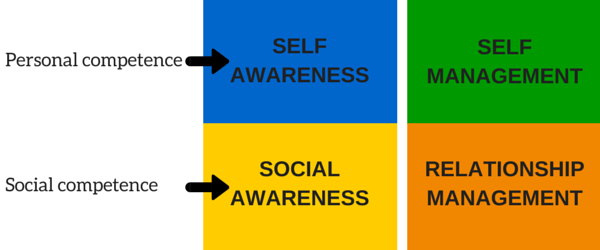Article summary
This is the first in a series on the excellent book Emotional Intelligence 2.0 by Drs. Travis Bradberry and Jean Greaves. What’s emotional intelligence? To summarize: We’re all humans, we all have emotions, and despite what we might tell ourselves, our emotions dictate our gut-level decisions and responses. Emotional intelligence skills kick in when it’s time to wrangle an emotional response into a productive and positive outcome.
The book segments emotional intelligence into four areas: self-awareness, self-management, social awareness, and relationship management.

In this post, I’d like to point out three specific tactics for improving self-management. What kinds of things can we do to respond well upon receiving input or feedback from others?
1. Breathe Right
It turns out we have much more lung capacity than we tend to use in our regular breathing. In fact, we don’t regularly breathe in as much as we should, and the higher-level reasoning parts of our brain are often starved of oxygen.
When you need a moment of clarity, or perhaps you have just received some negative input, take some time to take several deep breaths. The extra oxygen will help the higher-level brain kick in and start providing valuable input.

Give it a quick try. It feels good!
2. Count to 10
Let’s say you just received some negative input. You’re feeling irritated, defensive, and possibly angry. You could react right away. But I think you know what the result will be–further escalating the conversation into unsafe territory. That is almost certainly not what either party wants or intends.
Instead, slowly count to 10 in your head. Allow your higher-level brain to kick in and process the information. Perhaps it’s valid and worth considering. It may very well be invalid–in which case, the extra time will help in building a well-formed argument against it.
When delaying your response would make for an awkward social situation, the authors suggest that you mask what’s going on. Take a sip of tea, for example. Or take a long look out the window, as you make it clear to the other person that you’re carefully considering the situation.
3. Create an Emotion vs. Reason List
Again, let’s say you just received some difficult input. If you’ve got a little time on your hands, consider grabbing a sheet of paper and creating an emotion vs. reason list.
One one side of the paper, write down all of the emotions you’re feeling. On the other, write down the higher-level reasoning that’s going through your mind. This should take a few minutes.

When you’re done, review the list and reconsider what’s there. Are there some emotions that are not helping to resolve the situation? Scratch them off the list. Are there some arguments that are irrelevant and not helpful? Scratch those off as well. Now you’re in a good place to consider what’s left, what it means, and how you can summarize those points into your next steps.

I’ve found this is a useful way to sift through the helpful and unhelpful emotions and thoughts going through my head. I hope it helps you, too.
Wrap Up
Note the common theme between all three of the above tips–they buy you time before you make a reaction or decision. Our emotions can provide us with gut-level reactions, which in some cases are good, and in some cases bad. Buying time allows our higher-level, human brain functions to sift through a variety of responses and determine which one is best.
If you’d like to learn more, I strongly recommend reading Emotional Intelligence 2.0. It’s fairly short, well written, and most importantly, the tips are succinct, concrete, immediately actionable, and numerous. Don’t worry about nailing them all right away. I like to skim the list about once a month. Each time, I learn something new.
My huge thanks to the authors, and everyone else who’s done emotional intelligence work, in helping me and others improve our soft skills.
This is the first in a series on Emotional Intelligence 2.0 by Drs. Travis Bradberry and Jean Greaves.
- Improving Your Self-Management
- Improving Your Social Awareness
- Improving Your Relationship Management
- Improving Your Self-Awareness (coming soon)

